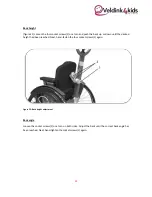
21
Equilibrium point
warning:
The moment when the wheelchair tilts forward, backward or sideward depends on the equilibrium
point and the stability. The most important adjustment of your wheelchair is the position of the seat
in relation to the rear wheels. The further to the back the seat is positioned the better the wheelchair
can be manoeuvred, but the risk of the wheelchair tilting backward increases as well.
Changing the adjustment of this wheelchair increases or reduces the risk of falling or tilting. Always
let experts carry out such adjustments.
1.
To prevent falling or tilting you should learn how to deal with the conditions of equilibrium.
You should not try and find out by yourself, but ensure you have some help. The anti-tilt
supports are an aid to prevent you from falling.
2.
The equilibrium point and the stability of your wheelchair are also affected by a change in
the position of your body and/or your posture. In addition, driving your wheelchair on a
slope or suspending a bag from the rear disturb the balance.
Dressing and changing
warning:
When you dress or change, your weight will shift in the wheelchair. This may cause falling or tilting
and result in serious bodily injury.
“Wheelies” (balancing on the rear wheels)
A “wheelie” is done by balancing on the rear wheels of the wheelchair with the front wheels free
from the ground. If this is done in a safe way it can help to negotiate kerbs and other obstacles.
warning:
It is dangerous to make a “wheelie”, because you may fall or tilt backward which can result in
serious injury. Always heed the following warnings:
1.
Discuss with your therapist or another competent person whether and how you can make a
“wheelie” in a safe manner.
2.
Never try to make a “wheelie” if you are not an experienced wheelchair driver or if there is
no help available.
















































